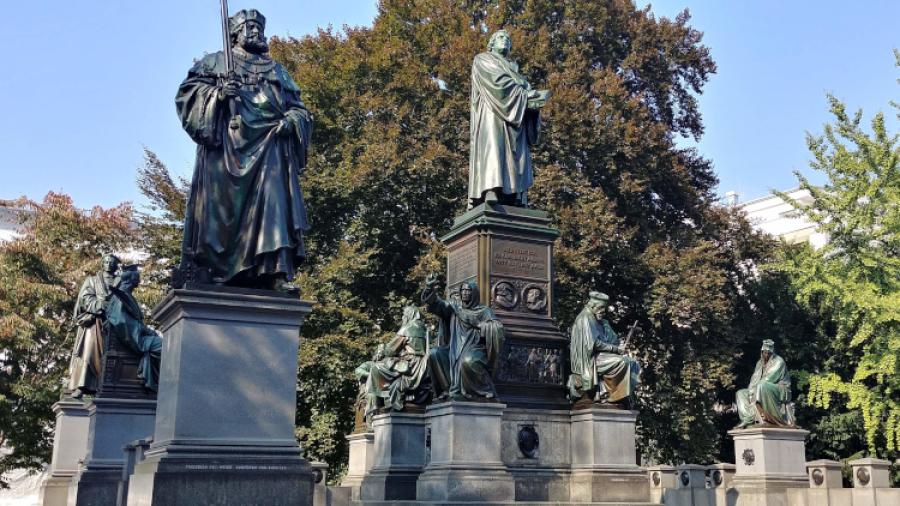The Reformation at 500: Luther’s Stand at Worms
Image

Read Part 1.
One of the most fascinating sights that we saw on our 500th-anniversary Reformation tour was the Luther Monument—sometimes called the Reformation Monument—which is located across the street from the park where Dr. Martin Luther’s famous stand before the Diet of Worms is memorialized.
In fact, this set of bronze sculptures is described as “the world’s largest monument to the Reformation.”1 Here Luther still takes his stand, proudly holding his German Bible at the very center of the monument, enveloped in the words of his famous hymn, “A Mighty Fortress is Our God.”2 He stands among his colleagues and others who paved the way for his work of Reformation. Looking at these figures, it is almost as if each one “being dead still speaks” (Heb. 11:4)3.
Beneath his feet—as his foundation, as it were—is this famous quote: “Hier stehe ich, ich kann nicht anders, Gott helfe mir: Amen!”
The drama that brought Luther to Worms on April 16, 1521, began officially on June 15 of the previous year, when Pope Leo X promulgated a papal bull against Luther that was titled Exsurge Domine, based on Ps. 74:22, in which he charged Luther with 41 false teachings.
Luther received the papal bull in October of 1520, and famously burned it in a celebration held at Wittenberg’s Elster Gate that Dec. 10. He was excommunicated in a second papal bull, titled Decet Romanum Pontificem, which Pope Leo X released on Jan. 3, 1521.
Erwin Lutzer, in his outstanding work called Rescuing the Gospel, summarizes the events that led to Worms: “Pope Leo X ignored Martin Luther’s request for a hearing, so Luther appealed to Charles V, the newly crowned emperor.”4
Lutzer then explains, “In other words, Luther appealed his case to Caesar.”5 The experience of his model in this regard, the Apostle Paul, is recorded in Acts 25:10-12 (see also Acts 25:21; 26:32; 27:24; 28:19).
And so, Luther went to Worms to appear before the men he had entreated in the short book he wrote the previous summer, called Address to the Christian Nobility of the German Nation.
His meeting with them on Wednesday, April 17, 1521, was very short. He was first asked to verify the authorship of his books. Then he was asked to recant those writings. The implied penalties for failing to comply were obvious.
There is a sense of mystery that shrouds Luther’s first stand before his accusers, which ended with his petition for a night of reflection. Was Luther afraid? Of course! Was he actually tempted to recant all of his works and avoid almost certain death? Certainly, he was tempted at some level—though it seems that his desire for additional time related more to searching for God’s wisdom than to hoping to find some means of escape.
Luther spent that night in prayer, and returned on Thursday, April 18, refreshed and resolute. His opening statement hung his opponents on the horns of a dilemma, for they were, in fact, demanding on penalty of death that he recant the official church teaching contained in several volumes.
But Luther’s cleverness only infuriated his enemies. They wanted a clear answer. And Luther delivered:
Unless I am convinced by Scripture and plain reason—I do not accept the authority of the popes and councils, for they have contradicted each other—my conscience is captive to the Word of God. I cannot and I will not recant anything for to go against conscience is neither right nor safe. God help me. Amen.6
Lutzer notes: “The earliest version added the words, ‘Here I stand, I cannot do otherwise,’ though the words were not recorded on the spot. Nevertheless, they are probably genuine.”7
Luther’s stand was based on unwavering faith, undergirded by raw courage. Disregarding the consequences, Luther mingled conviction with eloquence in such a way that his words still ring down to us.
May God help us likewise to stand.
Notes
1 “Luther: Widerrufsverweigerung Worms 1521;” Worms; n.d.; https://www.worms.de/en/web/luther/Tourismus/Luther-Rundgang/Lutherdenkm… Internet; accessed 15 April 2021.
2 For a complete description of the monument, see “Worms Lutherdenkmal: world’s largest Reformation monument;” Fotoeins Fotografie; n.d.; https://fotoeins.com/2017/05/15/worms-worlds-largest-luther-reformation-… Internet; accessed 15 April 2021.
3 Scripture taken from the New King James Version®. Copyright © 1982 by Thomas Nelson. Used by permission. All rights reserved.
4 Erwin W. Lutzer, Rescuing the Gospel (Grand Rapids: Baker Books, 2016), p. 76.
5 Ibid.
6 “Luther at the Imperial Diet of Worms (1521);” KDG Wittenberg; 1997; https://www.luther.de/en/worms.html; Internet; accessed 15 April 2021.
7 Lutzer, p. 82.
Paul Scharf 2019 Bio
Paul J. Scharf (M.A., M.Div., Faith Baptist Theological Seminary) is a church ministries representative for The Friends of Israel Gospel Ministry, serving in the midwest. He also assists Whitcomb Ministries and writes for “Answers” Magazine and Regular Baptist Press. For more information on his ministry, visit foi.org/scharf or email [email protected].
- 74 views


Discussion